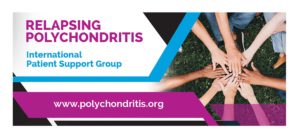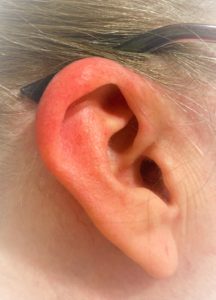As an engineer, I am naturally inquisitive, possibly bordering on obsessive if you were to ask my husband. For the past three months since the tentative diagnosis of Relapsing Polychondritis (the cool kids call it RP), I have been spending every free moment educating myself on this rare condition. This is not easy as limited cases mean limited research; the information floating around the internet is often based on outdated studies or inadequate sample sizes, and everything one reads must be taken with a healthy dose of skepticism. Despite these challenges, I managed to comb through every individual case study, comprehensive analysis, and credibly-sourced webinar I could find within the first month of my diagnosis.

RP is a chronic, progressively degenerative disease of the body’s own immune system that causes inflammation and subsequent damage to the cartilaginous and proteoglycan-rich connective tissues throughout the body with no known cure. The most common manifestations occur in the ears, nose, trachea, ribcage, and eyes, but it can attack other organs with similar tissues including the cardiovascular and central nervous systems. It commonly causes arthritis, but unlike rheumatoid arthritis, it is not usually destructive to these joints. Over time, the inflammatory response breaks down the intricate cell matrices in the cartilage regions attacked and replaces them with a structurally inferior protein called fibrinogen. The results vary by location. In the outer cartilage of the ear, or pinna, this can look like cauliflower ear or, conversely, cause the ears to droop, depending on if the fibrinogen is thick and rigid or thin and weak. If the inner ear is affected, the symptoms can include vertigo, tinnitus, and eventually hearing loss as the delicate auditory structures degrade. In the nose, this can cause a deformity known as “saddle-nose”. In the larynx and trachea, it can cause stenosis or collapse, and airway involvement is one of the reasons for increased risk of mortality. Symptoms coincide with increased periods of inflammations called flares that can persist for months or years, but the disease can subside into a period of remission, sometimes on its own, but more commonly with appropriate treatment. Relapses are typical, though, and give the disease its name: Relapsing Polychondritis. Even between flares, undetected latent inflammation can continue to cause damage, making the condition progressively harmful and insidious.
My own symptoms are scattered across a variety of systems, some yet to be determined if they are connected or just a coincidence. In 2018, I experienced a bout of sudden vertigo that sent me to the emergency room convinced I was having a stroke. In that same ER visit, the workup uncovered a left bundle branch block, tachycardia, and a heart murmur with no obvious risk factors for heart disease. I began 2020 with a nervous breakdown in Hawaii that was eventually suspected to be a temporal lobe focal seizure, and only one of many I must have experienced over the past two decades. Rewind twenty years and the complete loss of cartilage in my right ankle following septic shock at the age of 23 looks more and more suspicious. At some point in the decade that followed, I began to experience brief swelling and stinging pain in my salivary glands, and not long after I began experiencing intermittent episodes of double vision. For years I have been annoyed by dry eyes, facial flushing, and tinnitus. Some time after the pandemic started, I noticed a cycle of burning eyes, sore throat, hoarseness, and overwhelming fatigue that would hit at the end of the work week, only to disappear after a good night’s sleep. Most of these recurring symptoms were brief, lasting only from a few minutes to a few hours, and easy to attribute to stress, lack of sleep, or some other excuse before moving on with my life.
The verdict is still out on how much of these are just the unrelated complaints of a practiced hypochondriac or if any of it can now be attributed to the early symptoms of brewing RP. Similar stories can be found among the general population of patients with this disorder. Some can even point to recurring ailments as far back as their childhood that seem to suddenly make sense within the scope of their diagnosis at long last. The broad spectrum of possible symptoms, their obnoxious habit of spontaneously remitting and relapsing, and the too common lack of knowledge across the medical community of rare diseases in general usually lead to a delay in diagnosis from the onset of the first symptoms. It is commonly suspected by experts who study RP that the disorder is woefully under-diagnosed, the product of a healthcare system that values cutting costs over thorough diagnostics and habitually labels complaining women as emotional or hysterical. When the initial symptom is not the bright red, painful ear that characterizes classic RP, the delay in diagnosis can last until the tell-tale ear presents itself; for some patients, this symptom never manifests at all. A study out of Japan in 2016 suggests a higher prevalence of cardiovascular involvement than previously thought; it is feasible that some patients only have cardiac involvement, but never receive a diagnosis of RP because it is not a commonly accepted culprit by the medical community.
Statistics on morbidity and mortality found online cannot be trusted, so if you are reading this worried you may have RP, know that the outlook is not as bleak as Buzzfeed would have you believe. An individual’s prognosis is entirely dependent on a number of unique factors. These include how early they received the diagnosis, the specific organ systems affected, the presence of concomitant diseases, the quality of care they receive, and their own lifestyle choices. My own experience so far has shown me that stress is the most powerful contributor to my symptoms and my own mindset is an incredible force to counteract this.
The National Institute of Health (NIH) in the US is an organization most of us don’t really know much about. They provide research funding to other entities, but they also boast their own cutting edge research hospital with state of the art facilities and lead the globe in research studies for rare diseases. They began to focus on Relapsing Polychondritis only a few years ago, an effort driven by a secret weapon in the RP community: an NIH physician and fellow RP patient named Dr. Marcela Ferrada. Since beginning their focused research, a more detailed understanding of the various manifestations, categories, contributing causes, and potential therapies have developed. There is debate over whether RP is truly autoimmune or an autoinflammatory disease (read about their differences here), and some experts believe it is a form of small vessel vasculitis. About a third of RP patients also have another autoimmune disorder, the most common among these being Sjögren’s syndrome followed by vasculitis. RP isn’t considered hereditary, but there is a genetic link that may predispose patients to developing this or other similar autoimmune disorders.
I haven’t found a study that proposes a definitive cause for RP yet, but like other autoimmune conditions, it is likely a combination of factors with evidence of a triggering event. In my case, I suspect the severe illness I survived in my early twenties contributed, along with chronic stress, diet, and hormonal changes, culminating with a car accident last May that began the current spiral of systemic inflammation.

Every patient has their own theory about what triggered their first symptoms, and infection is a common tale. Early on I found an online support group with other RP patients and this has been an invaluable resource far beyond the difficult-to-read clinical studies.
Finding out you have RP is similar to winning the lottery, if notably less fun. The prevalence varies slightly according to which study you read, but it’s generally accepted to be around 3.5 new cases per million people annually. I am sharing this only to offer a reminder to anyone who is recently diagnosed- having a rare disease means we have already beaten the odds, so none of the other statistics are important. We’re capable of anything and that is all that matters now.
Further reading if you’d like to learn more about Relapsing Polychondritis:
Relapsing Polychondritis: An Updated Review (nih.gov)
Relapsing Polychondritis – NORD (National Organization for Rare Disorders) (rarediseases.org)


